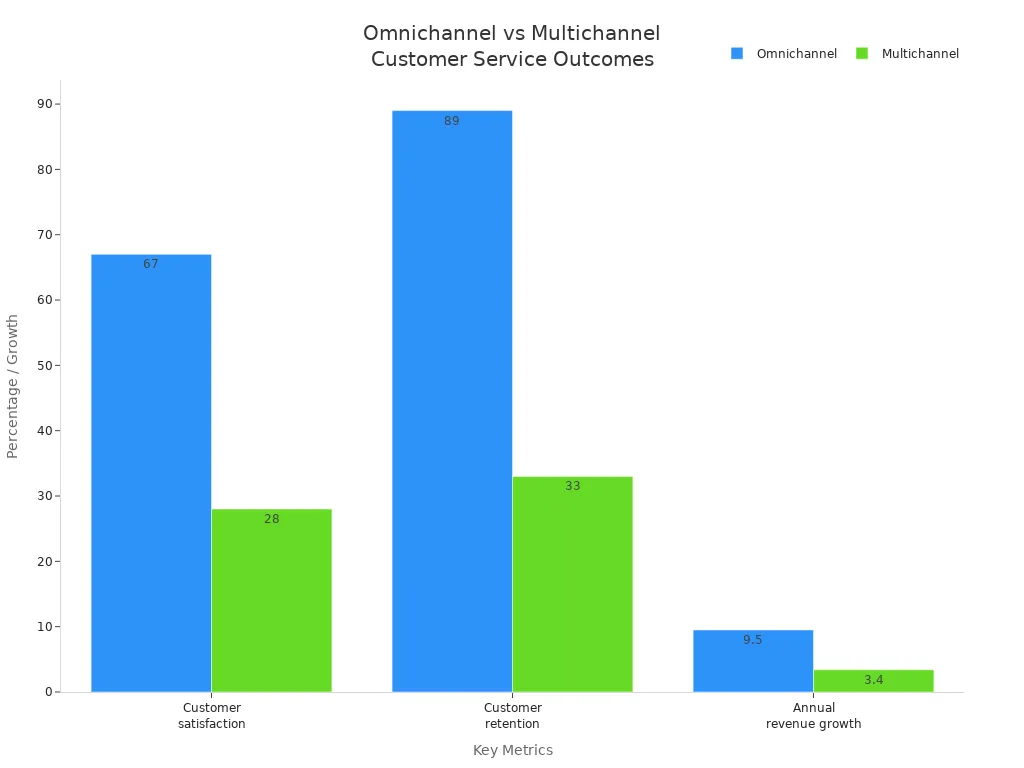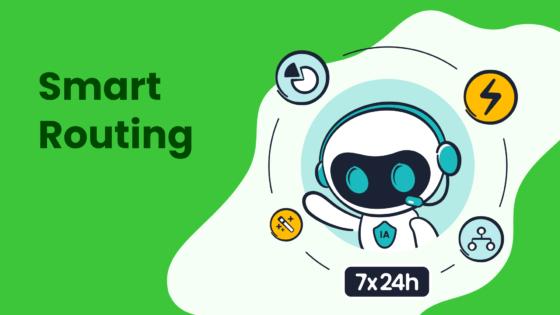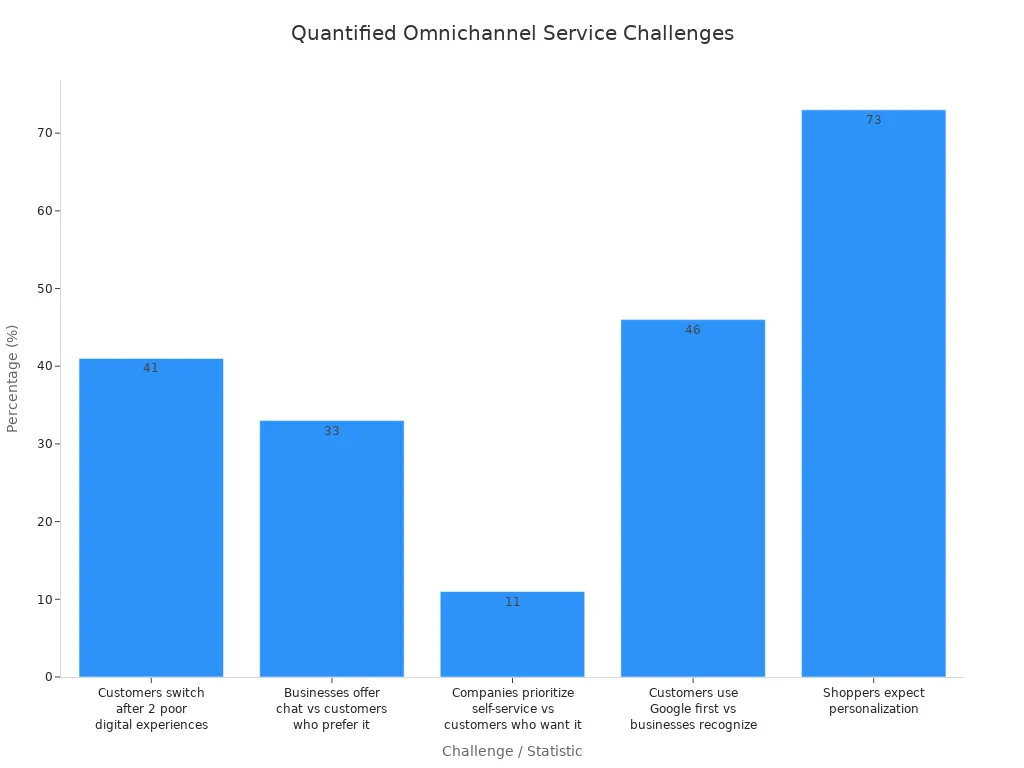Comparing Omnichannel and Multichannel Customer Service Approaches

The biggest difference between omnichannel and multichannel customer service lies in integration. Omnichannel connects every touchpoint, while multichannel keeps channels separate. This distinction matters because customers expect smooth, personalized support. Research shows 67% of customers feel satisfied with seamless omnichannel service, compared to only 28% with disconnected multichannel systems. Many businesses now use omnichannel tools, like Sobot and Sobot AI, to unify data and improve the customer experience.

You can see real omnichannel customer service examples in companies that use Sobot to deliver connected support across channels.
Omnichannel Customer Service
Definition
Omnichannel customer service means you connect all your communication channels into one system. You can talk to customers through email, chat, social media, or phone, and every conversation links together. This unified system lets you move from one channel to another without repeating your story. Agents see your full history, so you get help faster and more personally. The omnichannel approach creates a smooth journey for everyone. Unlike multichannel, where each channel stands alone, omnichannel support brings everything together for a seamless experience.
Core Features
You can spot an effective omnichannel strategy by looking for these features:
Agents know your preferences and past conversations, so they can personalize their help.
You get the same quality of service, no matter which channel you use.
The system uses unified data to spot trends and fix problems early.
Here’s a quick comparison:
Feature | Multichannel | Omnichannel |
|---|---|---|
Channel Operation | Separate | Connected |
Customer Experience | Inconsistent | Seamless |
Data Management | Siloed | Unified |
Service Continuity | Repetitive | Smooth |
Personalization | Limited | High |
Sobot Omnichannel Approach
Sobot’s omnichannel approach uses smart technology to connect every channel you use. You can reach out by chat, voice, email, or social media, and Sobot’s system keeps your information together. AI-powered chatbots and voice assistants answer simple questions right away. Intelligent routing sends your request to the best agent or channel. Sobot’s omnichannel support lets you enjoy fast, personalized help every time. The platform also uses predictive analytics to understand your needs and improve your experience. With Sobot, you get a true omnichannel marketing journey that builds loyalty and satisfaction.
Multichannel Customer Service
Definition
Multichannel customer service gives you many ways to reach a business. You can call, email, chat, use social media, or send SMS. Each channel works on its own, so you pick the one you like best. This multichannel approach helps you get support where you feel most comfortable. Businesses use this method to meet you where you are, making it easy to connect. A multichannel system does not link every channel together, but it gives you options. You might need to repeat your story if you switch channels, but you always have a way to get help. Many companies use a multichannel marketing strategy to reach more people and improve customer service.
Core Features
You can spot a multichannel approach by looking for these main features:
Multiple channels like phone, email, chat, and social media.
Each channel runs separately, so agents may not see your full history.
You choose your favorite way to contact support.
Agents handle questions on each channel, but information does not always move between them.
Automation, like chatbots, can answer simple questions on some channels.
Regular checks help improve each channel’s performance.
The multichannel marketing strategy lets businesses reach you in more places.
Tip: If you want fast answers, pick the channel that works best for your question. For example, use chat for quick help or phone for urgent issues.
Sobot Voice/Call Center

Sobot Voice/Call Center gives you strong support for a multichannel approach. You can reach out by phone, chat, or even social media. Sobot’s system lets agents manage calls and messages from one dashboard, making it easier to keep track of your needs. The platform uses smart routing to send your question to the right person. Voice recognition helps you get answers quickly. Sobot also connects with other business tools, so your information stays safe and organized. Real-time analytics show how well each channel works, helping teams improve customer service. With Sobot, you get a flexible multichannel marketing strategy that fits your business goals and customer needs.
Key Differences Between Omnichannel and Multichannel

Understanding the key differences between omnichannel and multichannel customer service helps you choose the right strategy for your business. Let’s break down these differences by looking at integration, customer experience, data management, and personalization.
Integration
Integration is the biggest difference between omnichannel and multichannel customer service. In an omnichannel system, you connect all your touchpoints into one platform. This means every chat, call, email, or social media message comes together. You can see the whole customer journey in one place. Multichannel customer service gives you many ways to reach out, but each channel stands alone. Your phone call does not link to your chat or email. You might have to repeat your story if you switch channels.
Here’s a table to show how integration works in both approaches:
Aspect | Omnichannel Customer Service | Multichannel Customer Service |
|---|---|---|
Channel Integration | All channels are integrated into a single platform, aggregating customer data and interactions in one place. | Channels operate independently without integration; interactions on one channel are not connected to others. |
Support Agent View | Agents have a complete view of the customer journey, enabling efficient and informed support. | Agents must manually gather information from separate channels, increasing workload and potential errors. |
Consistency & Branding | Ensures consistent service levels and branding across all channels. | Service levels and branding may vary between channels, causing inconsistency. |
Sobot’s all-in-one contact center platform brings every channel together. You get a unified experience across channels, making your support team more efficient and your customers happier.
Customer Experience
The quality of customer experience changes a lot between omnichannel and multichannel approaches. Omnichannel customer service gives you a seamless experience. You can start a conversation on one channel and finish it on another without losing context. You never have to repeat yourself. This creates a smoother customer experience and builds trust.
Multichannel customer service lets you use multiple touchpoints, but the journey feels fragmented. You might get different answers on different channels. You often need to explain your problem again if you switch from chat to phone. This can lead to frustration and lower satisfaction.
Note: Research shows that seamless transitions between channels improve customer satisfaction and loyalty. Companies like Amazon use omnichannel marketing to deliver consistent support and follow-ups, both online and offline.
Sobot’s omnichannel solution helps you deliver a seamless, personalized experience. You can track every step of the customer journey, making sure each interaction feels connected.
Data Management
Data management is another key difference between omnichannel and multichannel customer service. In an omnichannel system, all your customer data comes together. You can see every interaction, purchase, and feedback in one place. This helps you spot trends, solve problems faster, and improve the quality of customer experience.
Multichannel systems keep data in silos. Each channel stores its own information. This makes it hard to get a full picture of your customer. Agents might miss important details, leading to slower responses and less effective support.
Omnichannel systems use advanced technology like CRM and AI to keep data updated and synchronized.
Multichannel systems need less technology, but you lose out on insights and efficiency.
Sobot’s platform uses real-time analytics and AI to bring all your data together. You can make better decisions and offer more targeted support.
Personalization
Personalization sets omnichannel marketing apart from multichannel strategies. Omnichannel systems use centralized data to recognize you across all touchpoints. You get content and support based on your full history, not just one channel. This leads to a more personalized experience and higher engagement.
Multichannel customer service personalizes each channel separately. Your chat history does not connect to your email or phone call. This limits how much agents can tailor their help.
Aspect | Multichannel Personalization | |
|---|---|---|
Integration Level | Channels are integrated and coordinated, enabling a seamless, unified customer journey across all touchpoints. | Channels operate independently without integration, leading to fragmented and inconsistent experiences. |
Data Usage | Centralized data from all channels is used to tailor content and interactions based on cumulative customer behavior. | Personalization is limited to individual channels without continuity or shared data. |
Continuity Across Channels | Customers can switch channels without losing context; interactions are seamless and personalized. | Customers often face disjointed messaging and must repeat information when switching channels. |
Sobot’s AI-powered chatbots and unified workspace help you deliver true omnichannel marketing. You can engage customers with the right message at the right time, no matter where they reach out. Brands like Samsung and Michael Kors have seen a 25% increase in sales and a 30% drop in complaints after using Sobot’s omnichannel solution.
Tip: Omnichannel marketing helps you build loyalty by offering a seamless, consistent, and personalized experience across all touchpoints.
Omnichannel Customer Service Examples

Sobot and Opay Case Study
You can see how omnichannel customer service examples work in real life by looking at Sobot’s partnership with Opay. Opay needed to manage customer messages from many channels. Sobot helped Opay bring over 10 channels together into one AI-powered platform. This made it easy for agents to see all customer conversations in one place. Opay’s team answered questions faster and gave better support. The table below shows the main results:
Outcome Category | Description |
|---|---|
Response Time Reduction | 80% decrease in response times while keeping a human touch. |
Channel Unification | Over 10 channels combined into a single platform. |
Centralized Communication | All live chat, tickets, and messages managed in one hub. |
Operational Efficiency | Teams worked better together and spent less time on manual tasks. |
Customer Testimonials | Users noticed faster replies and smoother support across every channel. |
Sobot’s omnichannel solution helped Opay improve customer satisfaction and reduce costs. You can read more about this case on Sobot’s official blog.
Retail and Ecommerce
Omnichannel customer service examples in retail and ecommerce show how brands use technology to create a seamless shopping experience. Many companies use omnichannel retail strategies to connect online and offline shopping, often incorporating tools like The QR Code Generator (TQRCG) to bridge the gap. The table below highlights some well-known brands:
Brand | Omnichannel Strategy | Outcome / Why it works |
|---|---|---|
Walgreens | Mobile app for prescriptions, deals, and store pickup. | Makes shopping easier by linking mobile and in-store experiences. |
Nike | Nike+ app syncs user data for personalized offers and in-store digital ordering. | Digital sales rose 35%; loyalty grew with integrated online and offline marketing. |
Ralph Lauren | Chatbot suggests gifts; online orders with in-store pickup. | Blends digital and physical shopping for a unique experience. |
Amazon | Uses data across channels for personalized shopping and Prime loyalty. | Delivers a seamless, personalized journey and builds strong customer bonds. |
You can see how omnichannel retail helps brands boost sales and keep customers coming back. These omnichannel customer service examples show why many stores now use unified platforms like Sobot to manage all channels.
Financial Services
Financial companies also use omnichannel customer service examples to meet different customer needs. Some people want to visit a branch, while others prefer online chat or mobile apps. Omnichannel solutions help banks and financial firms serve everyone. You get secure, fast service whether you are online or in person. Studies show that 77% of customers are more likely to recommend brands with omnichannel engagement. Banks using these systems can cut costs by up to 25% and reach more customers. Omnichannel retail strategies in finance also help spot fraud faster and keep your money safe.
Benefit | Explanation | Supporting Data/Example |
|---|---|---|
Enhanced Customer Experience | Seamless, personalized service across channels increases satisfaction and loyalty. | 77% of customers more likely to recommend brands with omnichannel engagement. |
Increased Efficiency | Integrated systems reduce manual work and speed up service. | Operating expenses can drop by up to 25%. |
Greater Market Reach | Coordinated marketing across channels brings in more customers. | Omnichannel customers spend 4-5 times more than single-channel users. |
Improved Risk Management | Unified data helps spot fraud and manage risk quickly. | Faster detection of suspicious activity and better compliance. |
You can see how omnichannel customer service examples in finance help companies stay competitive and keep customers happy.
Benefits and Challenges
Omnichannel Approach
When you use the omnichannel approach, you give your customers a seamless experience across every channel. This method brings many benefits:
You increase customer satisfaction by letting people switch between chat, email, or phone without losing their place.
Your team sees all customer data in one place, which helps them give faster and more personal support.
You prevent customer churn by offering consistent and flexible service.
You boost team productivity because agents do not have to search for information in different systems.
You use AI and chatbots to answer simple questions, which saves time and improves customer engagement.
You collect feedback and use it to make your customer service better.
However, the omnichannel approach also brings challenges. Many companies struggle with connecting old systems, breaking down data silos, and making sure every department works together. The table below shows some common challenges and their impact:
Challenge Category | Specific Challenges | Impact | Solution |
|---|---|---|---|
Organizational | Siloed departments, different tools | Inconsistent customer experience | Standardize processes, align strategies |
Process | Undocumented or inconsistent processes | Hard to unify data, poor service continuity | Document and standardize before tech change |
Technological | Poor integration, scattered data, legacy systems | Slow service, manual work, errors | Use integration layers, analytics tools |

Note: 41% of customers switch brands after two poor digital experiences (NICE 2022 report).
Multichannel Approach
The multichannel approach gives your customers many ways to reach you, such as phone, email, chat, or social media. This method has several advantages:
You meet customer expectations by offering their favorite channels.
You improve customer satisfaction because people can choose how they want to connect.
You increase customer engagement and business growth by being available anytime and anywhere.
You prevent negative attention by supporting customers on social media.
Still, the multichannel approach has its own set of challenges:
Data integration is difficult because each channel stores information separately.
You may not understand customer behavior across all channels.
It is hard to measure which channels work best.
You need to divide resources carefully to avoid gaps in service.
Teams may not coordinate, leading to inconsistent customer service.
Tip: Companies that offer multichannel support see higher customer engagement, but must work hard to keep the experience unified.
Overcoming Challenges
You can overcome these challenges by building strong systems and focusing on the customer journey. Here are some proven strategies:
Invest in technology that connects all your channels and centralizes data.
Train your team to use new tools and understand customer needs.
Break down data silos by integrating CRM and order management systems.
Monitor performance and collect feedback to improve your strategy.
Route questions to the right channel and agent for faster help.
Sobot helps you solve these problems with its all-in-one platform. You get global phone numbers, smart task assignment, real-time monitoring, and seamless CRM integration. Sobot’s unified workspace lets your team see every customer interaction, which leads to improved customer satisfaction and a seamless experience. With Sobot, you can deliver consistent customer service and boost customer engagement across every channel.
Choosing the Right Customer Service Strategy
Business Needs
You should start by looking at your business goals and resources. If you want to offer many ways for customers to reach you but need a simple setup, a multichannel approach may fit. This method works well if you want cost-efficiency and easy management. However, if your goal is to deliver the best customer experience and build strong loyalty, you should consider an omnichannel strategy. This approach connects every channel and creates a single customer journey. You need to check if your team can handle more complex systems and if you have the resources for integration. Many companies, like PayPal, use an omnichannel strategy to give customers a smooth experience both online and offline. Here are some criteria to help you decide:
Do you want to unify customer data for better insights?
Is seamless communication across channels important for your brand?
Can you invest in technology and training for a connected system?
Are you aiming for premium, personalized support?
Tip: Businesses with limited resources may start with multichannel and add elements of omnichannel as they grow.
Customer Expectations
Customers today expect fast, consistent service on every channel. Studies show that 71% of people want the same experience no matter how they contact you, but only 29% feel they get it (source). An omnichannel strategy helps you meet these high expectations. You can track every interaction and offer real-time, personalized support. Customers do not want to repeat their story when they switch from chat to phone or email. With an omnichannel strategy, you make sure every agent sees the full history, so customers feel valued and understood. This approach leads to higher satisfaction and loyalty. In fact, 89% of customers are more likely to buy again after a positive omnichannel experience.
Transition Steps
If you want to move from multichannel to omnichannel, you can follow these steps:
Create a plan based on your business size, industry, and customer needs.
Choose technology that connects all your channels, like Sobot’s unified platform.
Train your team to use new tools and manage customer data across channels.
Standardize information, such as product details and promotions, on every channel.
Use automation to link actions between channels, so customers get quick help.
Monitor performance and collect feedback to keep improving.
Sobot makes this transition easier. Its AI-powered platform brings together chat, voice, email, and social media. You get smart routing, real-time analytics, and secure data management. Sobot helps you scale support and keep a human touch, making your move to an omnichannel strategy smooth and effective.
Omnichannel Marketing Strategy
Unified Messaging
Omnichannel marketing gives you the power to deliver a seamless experience across every channel. With unified messaging, you keep your brand voice and service quality the same, no matter where your customers reach out. This approach connects web chat, social media, email, and phone into one system. You never have to repeat your story, and agents always know your history.
Unified messaging brings all your conversations together, so you get a seamless journey.
You build trust and loyalty because your messages stay consistent.
Customers feel valued when they get personalized responses based on their full history.
Companies with strong omnichannel marketing keep 89% of their customers, while others keep only 33%.
Harvard Business Review found that omnichannel marketing strategies raise customer satisfaction by 23% (source).
Centralized communication lets you automate routine questions and save time.
71% of people feel frustrated with impersonal service, but omnichannel messaging helps you avoid this.
Sobot’s omnichannel capabilities make unified messaging easy. You can manage all channels in one dashboard, use AI to personalize replies, and keep your brand message strong everywhere.
Customer Journey
A seamless customer journey is the heart of omnichannel marketing. You guide your customers from the first touch to the final purchase without any breaks. When you use an omnichannel marketing strategy, you help customers move between channels without losing context.
Businesses with integrated omnichannel marketing keep up to 89% of their customers.
Customers who use more than one channel are 30% more likely to buy.
Seamless journeys can boost retention rates by 91%.
Key metrics like Customer Lifetime Value and Net Promoter Score improve with a strong omnichannel marketing strategy.
Personalized experiences across channels lead to higher loyalty and long-term growth.
Sobot supports your omnichannel marketing by combining AI, automation, and real-time analytics. You can track every step, understand customer behavior, and deliver seamless support. This approach helps you grow your business and keep your customers happy.
Omnichannel customer service connects every channel, while multichannel keeps them separate. You improve customer satisfaction and loyalty when you unify messaging and data. Sobot’s all-in-one contact center solution helps you deliver real-time support, predictive analytics, and personalized service. To get the best results:
Focus on integration and seamless customer journeys.
Use AI-powered tools for efficient, unified support.
Measure ROI with KPIs like CSAT and retention rates.
Invest in training and customization for your team.
Evaluate your current approach and explore omnichannel opportunities to boost your business success. Learn more about Sobot’s solutions at sobot.io.
FAQ
What is the main difference between omnichannel customer service and multichannel customer service?
Omnichannel customer service connects all your channels into one system. Multichannel customer service gives you many channels, but they work separately. With omnichannel, you get a seamless experience. Multichannel customer service may require you to repeat your story on each channel.
How does omnichannel marketing improve customer satisfaction?
Omnichannel marketing uses unified data to personalize every message. You get consistent support across chat, email, and phone. Studies show 89% of customers stay loyal after a positive omnichannel experience (Salesforce). Sobot’s platform helps you deliver this seamless journey.
Can Sobot help my business switch from multichannel customer service to omnichannel customer service?
Yes! Sobot’s all-in-one contact center solution brings chat, voice, email, and social media together. You can manage every customer interaction in one dashboard. Sobot’s AI and automation make the transition smooth and help you boost customer satisfaction.
Why is data integration important in omnichannel customer service?
Data integration lets you see every customer’s full journey. You can spot trends, solve problems faster, and personalize support. Sobot’s omnichannel customer service platform unifies your data, making it easy to track and improve every interaction.
What industries benefit most from omnichannel customer service?
Retail, financial services, gaming, and education see big gains from omnichannel customer service. For example, Opay improved customer satisfaction by 30% using Sobot’s omnichannel solution. Any business that wants better customer experience and loyalty can benefit.
Tip: Omnichannel customer service and omnichannel marketing help you build trust and keep customers coming back.
See Also
Comprehensive Overview Of Omnichannel Software For Call Centers
Step By Step Process To Deploy Omnichannel Contact Centers
Essential Guide To Quality Management Systems In Call Centers
